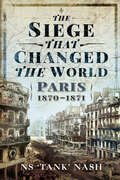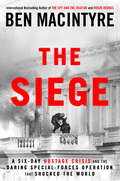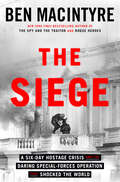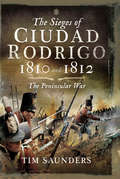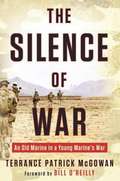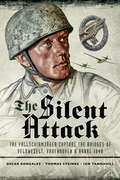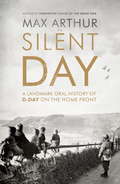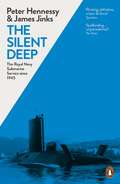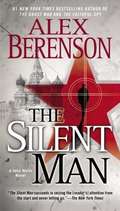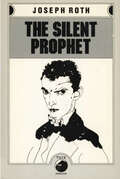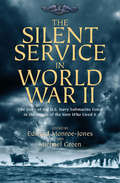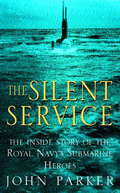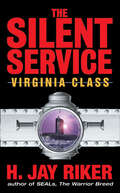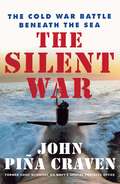- Table View
- List View
The Siege of Tsingtau: The German-Japanese War, 1914
by Charles Stephenson&“A well-written, modern narrative of the political and military events leading up to, during and after the German-Japanese War of 1914.&”—The Australian Naval Institute The German-Japanese War was a key, yet often neglected, episode in the opening phase of the First World War. It had profound implications for the future, particularly in respect of Japan&’s acquisition of Germany&’s Micronesian islands. Japan&’s naval perimeter was extended and threatened the United States naval strategy of projecting force westward. The campaign to relieve Germany of Tsingtau, the port and naval base in China, and its hinterland posed a grave threat to Chinese independence. The course of the Second World War in China and the Pacific cannot be explained without reference to these events. Charles Stephenson&’s account makes fascinating reading. The siege of Tsingtau by the Japanese, with token British participation, forms the core of his story. He draws on Japanese and German primary sources to describe the defenses, the landings, the course of the siege, and eventual German surrender. His study will be absorbing reading for anyone interested in the campaigns of the First World War outside of Europe, in German colonial expansion and the rise to power of Japan. &“Overall the volume delivers a much needed, interesting and often highly detailed overview of operations in the Pacific and the siege of Tsingtau. The volume excels especially in its detailed narrative of naval and land operations in the Pacific and in China. The geopolitical background provides a most useful introduction to the history of the region.&”—International Journal of Maritime History
The Siege that Changed the World: Paris, 1870–1871
by N S NashA fascinating account of the dramatic events leading up to the Siege and the four month siege itself.The Siege of Paris from September 1870 to the city’s capitulation in January 1871 was the result of Louis Napoleon III, Emperor of France’s disastrous decision to declare war on Prussia. The Prussian Army of King William I proved vastly superior to their adversaries. After victories at Metz and Sedan, the Prussians marched on Paris virtually unopposed. By 19 September the city was encircled with the population discontented, disillusioned and rebellious. Civil disorder was rife as starvation took a grip. On the inevitable surrender in late January and the declaration of the German Empire, France’s humiliation was complete. This in turn led to the temporary establishment of the Paris Commune an embryonic communist government, and civil war. As well as providing a vivid description of the siege and fighting, the author of this well researched account analyses the long-term effects be they social, military and political both on France and wider Europe. He argues that while the siege was not particularly costly in terms of human life, its legacy was the reduction of French global influence, the growth of German militarism, the evolution of international communism and changes in the world order.
The Siege: A Six-Day Hostage Crisis and the Daring Special-Forces Operation That Shocked the World
by Ben MacintyreA brilliant, seat-of-your-pants hostage-taking and daring SAS rescue mission of the Iran Embassy in London in 1980, this is Ben Macintyre at the very height of his story-telling powers.On April 30, 1980, six heavily armed gunmen burst into the Iranian embassy on Prince&’s Gate, overlooking Hyde Park in London. There, they took 26 hostages, including embassy staff, visitors, and three British citizens. A tense six-day siege ensued—all on television, over a Bank Holiday weekend—in which police negotiators and psychiatrists sought a bloodless end to the standoff, while the SAS laid plans for a daring rescue mission: Operation Nimrod.This mission marked a fundamental turning point in global history, when Middle Eastern terrorism arrived in the West. Britain had experienced IRA terrorism before, but never an international terrorist incident on this scale. It was a precursor to the brutal Iran-Iraq War that would follow, in which millions perished. Yet there exists to this day no full account of the week-long siege and gripping rescue.Drawing on interviews with police, hostages, terrorists and key SAS figures, and cutting through the sensationalism and misinformation, bestselling historian Ben Macintyre (author of Sunday Times #1s Colditz, The Spy and the Traitor and SAS: Rogue Heroes) goes deep into the archives with exclusive access to tell the story of what really happened and give the first definitive account of a moment that forever changed the way the nation thought about the SAS—and itself.
The Siege: A Six-Day Hostage Crisis and the Daring Special-Forces Operation That Shocked the World
by Ben Macintyre&“For six days, it was the Iranian Embassy on Princes Gate in London that riveted the world. . . . Macintyre&’s superb reconstruction restores it to vivid, complex life.&”—The Washington PostA thrilling tick-tock recounting one of the most harrowing hostage situations and daring rescue attempts of our time—from the true-life espionage master and New York Times bestselling author of Operation Mincemeat and The Spy and the Traitor.&“[Ben Macintyre is] John le Carré&’s nonfiction counterpart.&”—The New York TimesA BEST BOOK OF THE YEAR: The Washington Post, Minnesota Star Tribune, ParadeAs the American hostage crisis in Iran boiled into its seventh month in the spring of 1980, six heavily armed gunman barged into the Iranian embassy in London, taking twenty-six hostages. What followed over the next six days was an increasingly tense standoff, one that threatened at any moment to spill into a bloodbath. Policeman Trevor Lock was supposed to have gone to the theater that night. Instead, he found himself overpowered and whisked into the embassy. The terrorists never noticed the gun hidden in his jacket. The drama that ensued would force him to find reserves of courage he didn&’t know he had. The gunmen themselves were hardly one-dimensional—all Arabs, some highly educated, who hoped to force Britain to take their side in their independence battle against Supreme Leader Ayatollah Khomeini. Behind the scenes lurked the brutal Iraqi dictator Saddam Hussein, who had bankrolled the whole affair as a salvo against Iran.As police negotiators pressed the gunmen, rival protestors clashed violently outside the embassy, and as MI6 and the CIA scrambled for intelligence, Britain&’s special forces strike team, the SAS, laid plans for a dangerous rescue mission. Inside, Lock and his fellow hostages used all the cunning they possessed to outwit and outflank their captors. Finally, on the sixth day, after the terrorists executed the embassy press attaché and dumped his body on the front doorstep, the SAS raid began, sparking a deadly high-stakes climax.A story of ordinary men and women under immense pressure, The Siege takes readers minute-by-thrilling-minute through an event that would echo across the next two decades and provide a direct historical link to the tragedy on 9/11. Drawing on exclusive interviews and a wealth of never-before-seen files, Macintyre brilliantly reconstructs a week in which every day minted a new hero and every second spelled the potential for doom.
The Sieges of Ciudad Rodrigo, 1810 and 1812: The Peninsular War
by Tim SaundersThe area astride the Spanish/Portuguese border between the respective fortresses of Ciudad Rodrigo and Almeida was the focus of the Peninsular War for much of the period from the autumn of 1809 through until 1812. The fortress of Ciudad Rodrigo that dominated the country between the Rivers Agueda and Ca, was one of the Keys to Spain for any army attacking either east or west across the frontier.With the defeat of the Fifth Coalition at Wagram in 1809, Napoleon was free to turn his attention to the rebellious Iberian Peninsula and the small British Army. Tasking a reluctant Marshal Massna to 'throw the leopard into sea, preparations started for what proved to be a protracted and lacklustre siege. Marshal Ney, however, champed at the bit and wanted to press on with the invasion and despite an increasing tempo of outpost actions, such as the renowned affair at Barbra del Puerco, Napoleon in attempting to control events from Paris, insisted on an orderly siege.With the fall of Ciudad Rodrigo, Craufurds Light Division remained covering the Armys frontage but after a superbly conducted withdrawal, Craufurds judgement erred and he was force into a costly fighting withdrawal to the River Ca. The British now fell back into Portugal but by Spring 1811 they were back and with Napoleon stripping troops from the Peninsular Wellington could prepare to invade Spain and besiege Ciudad Rodrigo.Preparations for the siege were almost complete in December 1811, when further troops were stripped from Marshal Marmont, an opportunity to presented itself for a lightening operation to take Ciudad Rodrigo in the 1812 siege, which was of very different character.
The Silence of War: An Old Marine in a Young Marine's War
by Bill O'Reilly Terry McgowanWith a Foreword by Bill O'Reilly, here is the incredible memoir of a former Marine who returns to combat in Iraq and Afghanistan three decades after leaving the Corps.Terry McGowan had been a beat cop, a Marine captain, and a Special Agent for the FBI before retiring at the age of fifty. But when tragedy struck the United States on September 11th, 2001, Terry felt an undiminished sense of duty to protect and serve his country.Six years later, he was in Iraq as a member of a team of high ranking retired and active duty military working for the highest level of Marine military intelligence. His success in Iraq led to a position as a Law Enforcement Professional with the Marines in Afghanistan. There he found himself the oldest member of a platoon on the front line; a platoon that was understrength and under fire. While an eighteen year old Marine can't look at a crowd of Afghans and pick out the guilty party, with his years of experience in law enforcement, Terry had developed an eye for the "felony look".His training as a Marine Officer combined with his experience as an FBI Agent made him a unique asset as he struggled to keep up with young Marines while they humped over the mountains.In The Silence of War, Terry recounts the many trials of his life of service, providing an intimate glimpse into the horrible realities of modern military conflict.INCLUDES PHOTOSFrom the Hardcover edition.
The Silence of the Girls: A Novel (The Women of Troy Series)
by Pat BarkerA Washington Post Notable Book One of the Best Books of the Year: NPR, The Economist, Financial Times Shortlisted for the Costa Novel Award Finalist for the Women&’s Prize for FictionHere is the story of the Iliad as we&’ve never heard it before: in the words of Briseis, Trojan queen and captive of Achilles. Given only a few words in Homer&’s epic and largely erased by history, she is nonetheless a pivotal figure in the Trojan War. In these pages she comes fully to life: wry, watchful, forging connections among her fellow female prisoners even as she is caught between Greece&’s two most powerful warriors. Her story pulls back the veil on the thousands of women who lived behind the scenes of the Greek army camp—concubines, nurses, prostitutes, the women who lay out the dead—as gods and mortals spar, and as a legendary war hurtles toward its inevitable conclusion. Brilliantly written, filled with moments of terror and beauty, The Silence of the Girls gives voice to an extraordinary woman—and makes an ancient story new again.
The Silent Attack: The Fallschirmjäger Capture of the Bridges of Veldwezelt, Vroenhoven & Hanne 1940
by Thomas Steinke Ian Tannahill Óscar González&“An enthralling account of how German Special Forces fought to take and hold the key river crossings to allow the main German Army to swarm into France.&”—Firetrench Much has been written about the capture of Fort Eben-Emael in Belgium by German paratroopers, on May 10, 1940. This operation marked the first use of gliders and shaped charges—and proved it possible to drop paratroopers behind enemy lines. Training, secrecy, accuracy and speed linked to the element of surprise made these men lethal, causing chaos among Belgian soldiers. However, it should be stressed that these paratroopers were part of a larger group: The Sturmablteilung Koch (Koch Assault Group), the elite of the Luftwaffe in 1940, whose mission was not only to take Eben-Emael, but also the three bridges over the Alberto Canal near Veldwezelt, Vroenhoven, and Kanne. The success of the attack on Belgium and France would depend on the rapid conquest of those bridges. The aim of this book is to show how the assault on the Albert Canal bridges was planned and carried out, based on documents, records and evidence, and also through many photos never published until now. Every detail—from the creation of the Koch Assault Group to the final attack—has been impeccably researched, as well as verified through testimonies of Belgian and German soldiers. &“An impressive and beautifully presented book, with a meticulously researched, clear and readable narrative which is generously supported by innumerable photographs, first-hand accounts and a complete list of all those who took part. This must be considered an important addition to the library of airborne literature.&”—Pegasus Archive
The Silent Child: Haunting and thought-provoking historical fiction set during WWII
by J.G. Kelly'Outstanding. Heartstopping. Brilliant. A story that scorches the page, searing in its honesty and profoundly moving in its emotional impact. The characters reach out to you and challenge your preconceptions in this testament to a tragic chapter of history that moved me to tears. It holds up a dark and shocking mirror to our world, yet ultimately it is a triumphant tale of light within darkness. This is an important, powerful novel that everyone should read' KATE FURNIVALLSHE CAN'T HAVE A FUTURE UNTIL SHE HAS A PAST.1944LEO STERN arrives at the Nazi camp at Borek with his wife Irena and his two daughters. The Sterns are spared from the gas chamber when they witness a murder. But in a place that humanity has deserted, Leo is forced to make unimaginable choices to try to keep his family alive. 1961 For seventeen years, Hanna has been unable to remember her identity and how she was separated from her family at the end of the war, until the discovery of a letter among her late uncle's possessions reveals her real name - HANNA STERN - and leads her to Berlin in search of her lost past.Helped by former lover Peter, Hanna begins to piece together the shocking final days of Borek. But Hanna isn't the only one with an interest in the camp, and lurking in the shadows is someone who would prefer Hanna's history to remain silent. Based on in-depth research and beautifully written, this a novel of memory and identity, and the long shadow of war.'This book was such a beautifully written book that will stay with me for a long time. The storyline was emotive and heart wrenching and the characters were well developed and have a special place in my heart. I didn't want this book to end. Nothing I could say would do this book justice, I cannot recommend this book enough' Reader review
The Silent Child: Haunting and thought-provoking historical fiction set during WWII
by J.G. Kelly'Outstanding. Heartstopping. Brilliant. A story that scorches the page, searing in its honesty and profoundly moving in its emotional impact. The characters reach out to you and challenge your preconceptions in this testament to a tragic chapter of history that moved me to tears. It holds up a dark and shocking mirror to our world, yet ultimately it is a triumphant tale of light within darkness. This is an important, powerful novel that everyone should read' KATE FURNIVALLSHE CAN'T HAVE A FUTURE UNTIL SHE HAS A PAST.1944LEO STERN arrives at the Nazi camp at Borek with his wife Irena and his two daughters. The Sterns are spared from the gas chamber when they witness a murder. But in a place that humanity has deserted, Leo is forced to make unimaginable choices to try to keep his family alive. 1961 For seventeen years, Hanna has been unable to remember her identity and how she was separated from her family at the end of the war, until the discovery of a letter among her late uncle's possessions reveals her real name - HANNA STERN - and leads her to Berlin in search of her lost past.Helped by former lover Peter, Hanna begins to piece together the shocking final days of Borek. But Hanna isn't the only one with an interest in the camp, and lurking in the shadows is someone who would prefer Hanna's history to remain silent. Based on in-depth research and beautifully written, this a novel of memory and identity, and the long shadow of war.'This book was such a beautifully written book that will stay with me for a long time. The storyline was emotive and heart wrenching and the characters were well developed and have a special place in my heart. I didn't want this book to end. Nothing I could say would do this book justice, I cannot recommend this book enough' Reader review
The Silent Child: Haunting and thought-provoking historical fiction set during WWII
by J.G. KellySHE CAN'T HAVE A FUTURE UNTIL SHE HAS A PAST.1944LEO STERN arrives at the Nazi camp at Borek with his wife Irena and his two daughters. The Sterns are spared from the gas chamber when they witness a murder. But in a place that humanity has deserted, Leo is forced to make unimaginable choices to try to keep his family alive. 1961 For seventeen years, Hanna has been unable to remember her identity and how she was separated from her family at the end of the war, until the discovery of a letter among her late uncle's possessions reveals her real name - HANNA STERN - and leads her to Berlin in search of her lost past.Helped by former lover Peter, Hanna begins to piece together the shocking final days of Borek. But Hanna isn't the only one with an interest in the camp, and lurking in the shadows is someone who would prefer Hanna's history to remain silent. Based on in-depth research and beautifully written, this a novel of memory and identity, and the long shadow of war.(P) 2022 Hodder & Stoughton Limited
The Silent Day: A Landmark Oral History of D-Day on the Home Front
by Max ArthurOn 6 June 1944 Britain woke up to a profound silence. Overnight, 160,000 Allied troops had vanished and an eerie emptiness settled over the country. The majority of those men would never return. This is the story of that extraordinary 24 hours.Using a wealth of first person testimonies, renowned historian Max Arthur recounts a remarkable new oral history of D-Day, beginning with the two years leading up to the silent day which saw the UK transformed by the arrival of thousands of American and Canadian troops. We also hear the views of the American troops, who quickly formed strong views of both the British military and civilian populations. Then, on that June morning, many Britain people woke up to discover that vast areas of the country, which had throbbed with life only the day before, were now empty and silent. Civilian workers found coffee pots still warm on the stove but not a soul to greet them. Many women - and children - felt bewildered and betrayed.Then, throughout that day and the days that followed, the whole population gathered around wireless sets, waiting for news. There are powerful testimonies from families of who lost loved ones on the beaches of Normandy, and dramatic personal accounts from young widows who had never had the chance to say goodbye.THE SILENT DAY is an original and evocative portrait of a key event in world history, and a poignant reminder of the human cost of D-Day.
The Silent Day: A Landmark Oral History of D-Day on the Home Front
by Max ArthurOn 6 June 1944 Britain woke up to a profound silence. Overnight, 160,000 Allied troops had vanished and an eerie emptiness settled over the country. The majority of those men would never return. This is the story of that extraordinary 24 hours.Using a wealth of first person testimonies, renowned historian Max Arthur recounts a remarkable new oral history of D-Day, beginning with the two years leading up to the silent day which saw the UK transformed by the arrival of thousands of American and Canadian troops. We also hear the views of the American troops, who quickly formed strong views of both the British military and civilian populations. Then, on that June morning, many Britain people woke up to discover that vast areas of the country, which had throbbed with life only the day before, were now empty and silent. Civilian workers found coffee pots still warm on the stove but not a soul to greet them. Many women - and children - felt bewildered and betrayed.Then, throughout that day and the days that followed, the whole population gathered around wireless sets, waiting for news. There are powerful testimonies from families of who lost loved ones on the beaches of Normandy, and dramatic personal accounts from young widows who had never had the chance to say goodbye.THE SILENT DAY is an original and evocative portrait of a key event in world history, and a poignant reminder of the human cost of D-Day.
The Silent Deep: The Royal Navy Submarine Service Since 1945
by Peter Hennessy James Jinks'The Ministry of Defence does not comment upon submarine operations' is the standard response of officialdom to enquiries about the most secretive and mysterious of Britain's armed forces, the Royal Navy Submarine Service. Written with unprecedented co-operation from the Service itself and privileged access to documents and personnel, The Silent Deep is the first authoritative history of the Submarine Service from the end of the Second World War to the present. It gives the most complete account yet published of the development of Britain's submarine fleet, its capabilities, its weapons, its infrastructure, its operations and above all - from the testimony of many submariners and the first-hand witness of the authors - what life is like on board for the denizens of the silent deep.Dramatic episodes are revealed for the first time: how HMS Warspite gathered intelligence against the Soviet Navy's latest ballistic-missile-carrying submarine in the late 1960s; how HMS Sovereign made what is probably the longest-ever trail of a Soviet (or Russian) submarine in 1978; how HMS Trafalgar followed an exceptionally quiet Soviet 'Victor III', probably commanded by a Captain known as 'the Prince of Darkness', in 1986. It also includes the first full account of submarine activities during the Falklands War. But it was not all victories: confrontations with Soviet submarines led to collisions, and the extent of losses to UK and NATO submarine technology from Cold War spy scandals are also made more plain here than ever before. In 1990 the Cold War ended - but not for the Submarine Service. Since June 1969, it has been the last line of national defence, with the awesome responsibility of carrying Britain's nuclear deterrent. The story from Polaris to Trident - and now 'Successor' - is a central theme of the book. In the year that it is published, Russian submarines have once again been detected off the UK's shores. As Britain comes to decide whether to renew its submarine-carried nuclear deterrent, The Silent Deep provides an essential historical perspective.
The Silent Hero: A true escape story from World War II
by George SheaThe true story of a young deaf French boy, Pierre, who rescues an Allied pilot and helps him back across enemy lines during World War II.
The Silent Man
by Alex BerensonThe New York Times bestselling author of The Ghost War and The Faithful Spy CIA agent John Wells has spent years in the company of evil men. He's paid the price and is beginning to doubt if he can ever live a normal life. And when a powerful adversary from his past finds him, Wells must once again enter the fray. For his country. For his soul. For revenge...
The Silent Man (John Wells Series #3)
by Alex BerensonStealing warheads from the heart of Russia's nuclear complex isn't easy. It requires money, coordination, ingenuity, sleight-of-hand, and just a touch of luck. But if you're determined enough, if you're willing to die--and to kill--to get inside, anything is possible. CIA agent John Wells thought he'd reached his limits when he nearly died while stopping a plot that could have drawn the United States and China into war. Wells is exhausted and his nights are filled with disturbing dreams, but he knows he must gather his strength. He has made many enemies, and the world won't stay quiet for long. Nevertheless, he is not prepared for what is about to happen. Wells and his colleague--and fiancee--Jennifer Exley are on their way to work at Langley when traffic comes to a standstill. An accident has blocked the bridge ahead. Wells begins to get a bad feeling, a feeling that gets worse when he spots the motorcycle zooming up between cars toward him. Within a few minutes, several people will be dead or severely injured, Exley among them, and Wells will be a man possessed. Wells believes he knows who is behind the attack. He wants revenge for himself, despite the pleas of his bosses at the CIA, and even of Exley, that he wait. But as he tracks his adversaries to Russia, and then Europe, he will find much more than he expects. An Islamic terrorist plan of unimaginable/consequences is in motion. As he tries to stop it, Wells will have to decide how much his honor is worth-- and whether he can face losing the woman he loves. Real-world threats, authentic details, a scenario both dramatic and plausible--Berenson's new novel is another "timely reminder of the extremely precarious way we live now" (The Washington Post).
The Silent Prophet
by Joseph RothThe renowned author of The Radetzky March examines the mind of a Russian Revolutionary and the limitations of ideology in this classic n ovel.Based on his own observations during an extended stay in Moscow in the winter of 1926, The Silent Prophet is Joseph Roth’s vivid attempt to explain the Russian Revolution and its betrayal by exposing the personal motivations of its leaders. Written at the height of speculation about the fate of Marxist Revolutionary Leon Trotsky, it is a brilliant portrayal of revolutionary idealism-turned-cynicism.The illegitimate and rootless Friedrich Kargan—the Trotsky figure—becomes a leader of the Red Army during the civil war. But he soon realizes that the ideals he fought for were already lost. after openly defying the coldly amoral Savelli—the novel’s Stalin figure—Kargan is sent into exile in Siberia.
The Silent Service in World War II: The Story of the U.S. Navy Submarine Force in the Words of the Men Who Lived It
by Michael Green Ed And Edward Monroe-JonesFrom the naval battle of Guadalcanal to rescuing George Bush Sr. in the Pacific, here are the stories of US submariners in WWII. The Silent Service in World War II tells the story of America&’s intrepid submarine warriors in the words of the men who served and fought in the Pacific against Japan. When Pearl Harbor was attacked in 1941, the enemy had already deployed naval forces, but the United States was soon able to match them. By 1943, new Gato-class submarines were making a difference, carrying the war not just to the Japanese Imperial Navy, but to the vital merchant fleet that transported essential resources to the island country. Starting with the American victory at Guadalcanal, US submarine forces began to constrict the Japanese sea lanes. Operating independently and in wolfpacks, they attacked convoys operating beyond the range of American airpower, making daring forays even into Japanese home waters. Taking on Japanese warships, as well as rescuing downed airmen—including the grateful first President Bush—US submarines made an enormous contribution to our war against Japan. Aside from enemy action, the sea itself could be an extremely hostile environment—as many of these stories attest. From early war patrols in obsolescent, unreliable S-boats to modern fleet submarines roving the Pacific, the forty-six stories in this anthology offer a full understanding of life as a US Navy submariner in combat.
The Silent Service: The Inside Story of the Royal Navy's Submarine Heroes
by John ParkerOne of the great untold stories of the British services is that of the Royal Navy Submarine Service which entered the fray in World War I with 100 underwater craft. Through World War II, where submariners' prospects of returning safely from a mission were only 50:50, the Falklands conflict and the sinking of the Belgrano, to present-day elite machines, the Silent Service has played an enormous part in British defence. John Parker's in-depth investigation is very much personality led with diaries from the early part of the century to substantial first-person testimony from survivors of wartime heroics (when many VCs were won).
The Silent Service: The Inside Story of the Royal Navy's Submarine Heroes
by John ParkerOne of the great untold stories of the British services is that of the Royal Navy Submarine Service which entered the fray in World War I with 100 underwater craft. Through World War II, where submariners' prospects of returning safely from a mission were only 50:50, the Falklands conflict and the sinking of the Belgrano, to present-day elite machines, the Silent Service has played an enormous part in British defence. John Parker's in-depth investigation is very much personality led with diaries from the early part of the century to substantial first-person testimony from survivors of wartime heroics (when many VCs were won).
The Silent Service: Virginia Class (Silent Service Ser. #3)
by H. Jay RikerA crew of American naval submariners go up against an unidentified terrorist threat in this military thriller from a U.S. Navy veteran.The U.S.S. Virginia— the first in the most technologically advanced new class of U.S. attack submarines—sets sail, even as the Navy’s high-tech submarine program falls under attack from a Congress ready to cut military spending. But a threat no one anticipated is gliding silently through dangerous waters. A rogue Kilo-class submarine built by a shadowy and powerful ally has become the latest weapon in al Qaeda’s terrorist arsenal. The submarine’s brutal strikes have created a volatile hostage situation in the Pacific . . . and have left hundreds of people dead.This new and stealthy terrorist threat must be eliminated before more innocent lives are lost. But the officers, crew, and Navy SEALs aboard the Virginia will face more than they anticipated in the turbulent waters of the South China Sea—as one untried American sub races toward an explosive confrontation with a cunning, and ruthless enemy.
The Silent War: The Cold War Battle Beneath the Sea
by John Pina CravenThe Cold War was the first major conflict between superpowers in which victory and defeat were unambiguously determined without the firing of a shot. Without the shield of a strong, silent deterrent or the intellectual sword of espionage beneath the sea, that war could not have been won. John P. Craven was a key figure in the Cold War beneath the sea. As chief scientist of the Navy's Special Projects Office, which supervised the Polaris missile system, then later as head of the Deep Submergence Systems Project (DSSP) and the Deep Submergence Rescue Vehicle program (DSRV), both of which engaged in a variety of clandestine undersea projects, he was intimately involved with planning and executing America's submarine-based nuclear deterrence and submarine-based espionage activities during the height of the Cold War. Craven was considered so important by the Soviets that they assigned a full-time KGB agent to spy on him. Some of Craven's highly classified activities have been mentioned in such books as Blind Man's Bluff, but now he gives us his own insights into the deadly cat-and-mouse game that U.S. and Soviet forces played deep in the world's oceans. Craven tells riveting stories about the most treacherous years of the Cold War. In 1956 Nautilus, the world's first nuclear-powered submarine and the backbone of the Polaris ballistic missile system, was only days or even hours from sinking due to structural damage of unknown origin. Craven led a team of experts to diagnose the structural flaw that could have sent the sub to the bottom of the ocean, taking the Navy's missile program with it. Craven offers insight into the rivalry between the advocates of deterrence (with whom he sided) and those military men and scientists, such as Edward Teller, who believed that the United States had to prepare to fight and win a nuclear conflict with the Soviet Union. He describes the argument that raged in the Navy over the reasons for the tragic loss of the submarine Thresher, and tells the astonishing story of the hunt for the rogue Soviet sub that became the model for The Hunt for Red October -- including the amazing discovery the Navy made when it eventually found the sunken sub. Craven takes readers inside the highly secret DSSP and DSRV programs, both of which offered crucial cover for sophisticated intelligence operations. Both programs performed important salvage operations in addition to their secret espionage activities, notably the recovery of a nuclear bomb off Palomares, Spain. He describes how the Navy's success at deep-sea recovery operations led to the takeover of the entire program by the CIA during the Nixon administration. A compelling tale of intrigue, both within our own government and between the U.S. and Soviet navies, The Silent War is an enthralling insider's account of how the submarine service kept the peace during the dangerous days of the Cold War.
The Silent Witness
by Dani SinclairMysterious, secretive...and sexier than ever!Good girl Nicki Michaels once had a steamy affair with wild, sexy Alex Coughlin-but he'd left town without a word. When he returned and kept his distance, Nicki hid her broken heart and held her head high. Then she became a witness to murder...and Alex came to protect her.Alex stayed away to keep Nicki safe from his undercover investigation-now she was in the middle of it. The fiery beauty rekindled passion Alex thought he could control, until he tasted her lips once more. With a killer trying to silence Nicki, love was a distraction Alex couldn't afford-and one he could no longer deny...
The Silent Witness: A True Story Of The Civil War
by Robin FriedmanAt the beginning of the Civil War, Lula McLean’s family home in Manassas, Virginia, is taken over by the Confederate army and used as its headquarters. Forced to flee by the oncoming Union army, Lula and her family and her favorite rag doll move south to a small village called Appomattox Court House. Then one day in 1865, Lula left her doll behind, and what happened next made history.

